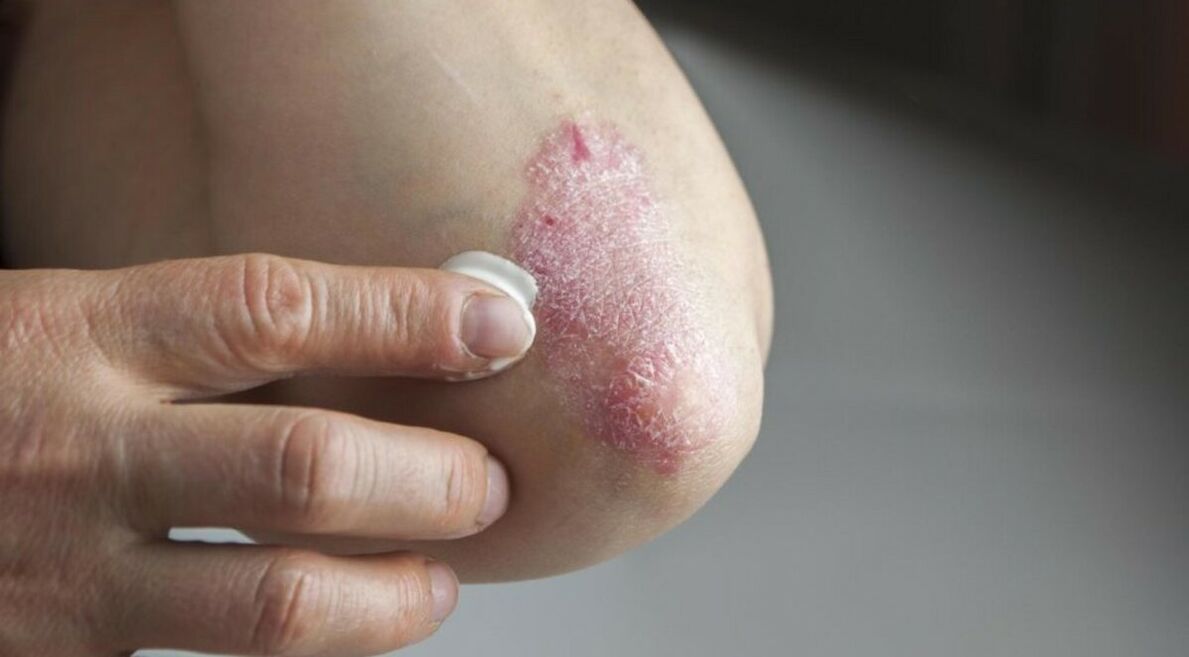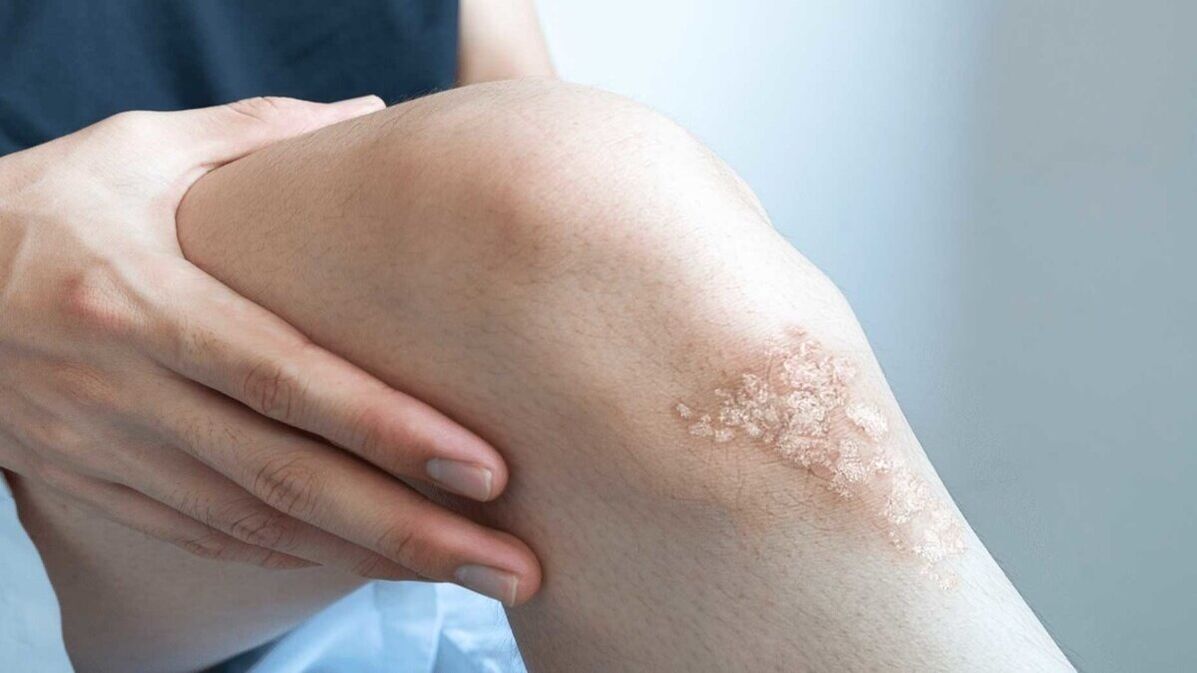
Psoriasis is a skin disease in which red patches with silvery scales appear on the skin.
Depending on the type, psoriasis affects the knees, elbows, trunk, nails, face or scalp.
What is psoriasis?
Psoriasis is an autoimmune disease that causes skin cells to grow too quickly, accumulate and form inflamed red patches. Symptoms of psoriasis can vary depending on the type, stage, and cause. General signs of psoriasis:
- inflamed skin areas;
- silvery-white scales or patches on red spots;
- pain and burning skin;
- dry, cracked skin (may itch and bleed);
- stiff and swollen joints;
- Thick, ribbed nails.
Psoriasis in children often first affects the scalp and nails, then spreads to the elbows, knees and trunk. With nail psoriasis in children, depending on the type of psoriasis, thick nails without pits or with small ridges can be observed, as well as yellowing or separation of the nails from the bed.
If you notice the first signs of psoriasis, you should consult your doctor. A dermatologist deals with the diagnosis and treatment of psoriasis in adults. If red spots on the skin or silvery scales appear in a child, you should consult a pediatrician.
How does psoriasis start?
Psoriasis begins with the formation of small red raised bumps a few millimeters above the skin (similar in appearance to a common rash). As they increase in size, white or silvery scales may appear. The scales above may fall off. The remaining scales stick together and begin to hurt and itch. When you scratch the rash, the scales can peel off the skin, causing bleeding.
What does psoriasis look like?
With psoriasis, red spots appear on light skin and brown or purple spots on dark skin. In the early stages of scalp psoriasis, the spots resemble dandruff (due to white flakes). Types of psoriasis:
- mild form of psoriasis (less than three percent of the body is affected, the rash is localized on the scalp or extremities);
- moderate form of psoriasis (rash covers 3 to 10% of the body, affecting the scalp, arms, legs, and trunk);
- severe form of psoriasis (more than 10% of the body is affected, the rash appears on the palms of the hands, soles of the feet and face).
Psoriasis treatment is chosen by a dermatologist depending on the type and type of psoriasis, symptoms, and location of the rash. If not treated properly or promptly, large damaged areas will appear on the skin.
Where can psoriasis occur?
The location of psoriasis spots depends on its type. Types of psoriasis:
- plaque psoriasis (vulgar). Plaque psoriasis causes dry, raised patches of skin covered with silvery scales. Psoriasis appears on the elbows, knees, lower back, and scalp;
- erythematous psoriasis. Skin looks burned, chills and temperature rise;
- Guttate psoriasis. Small, flesh-colored scaly spots, resembling drops of water, form on the arms, legs, and trunk;
- pustular psoriasis. With pustular psoriasis, white blisters filled with pus and large areas of inflammation form on the skin. Localized to small areas of skin, affecting the legs or arms;
- exudative psoriasis. Yellow scaly spots appear on the skin;
- Inverse psoriasis. Fine red spots appear on the skin. The rash occurs in skin folds (armpits, buttocks, genitals).
In nail psoriasis, skin accumulates under the nails, causing them to rise and form indentations ("nail pits"). The skin under the nail plate becomes white, yellow or brown. Nails become rough, brittle and quickly break.
Dermatologists also differentiate palmar psoriasis. Skin with psoriasis on the palms of the hands and feet is dry and prone to cracking.
Eyelid psoriasis causes redness, peeling, and scaling around the eyelids. Other symptoms of psoriasis on the eyelids:
- the formation of scabs that peel off and stick to the eyelashes;
- pain when moving eyes;
- eyelid skin irritation, accompanied by pain and itching.
The eyelid margin may be raised or lowered depending on the location of the spot, leading to friction between the eyelashes and eyeball. Possible consequences of eyelid psoriasis include uveitis (eye inflammation) and vision loss.
Psoriasis can appear on the eyebrows, behind and around the ears, and in the ear canal. Sometimes psoriasis affects the mouth, causing redness and burning of the lips, gums, tongue and cheeks. Oral psoriasis can make it difficult to chew and swallow food.
Manifestations of psoriasis depend on the type, symptoms and stage of the disease. Psoriasis can be seen in the photo.



Causes of psoriasis development
Psoriasis is caused by a malfunction of the immune system, in which white blood cells mistakenly begin to attack skin cells. Due to the activity of leukocytes, the production of new skin cells is reduced from a month to a few days. Previously formed cells are pushed by the body to the surface of the skin, where they accumulate and turn into spots or patches.
Genetic predisposition (family history of psoriasis) or triggers (environmental factors that increase the risk of psoriasis) can lead to malfunctions in the immune system. Factors that stimulate the development of psoriasis:
- infections (tonsillitis, herpes, lichen);
- skin injuries (sunburn, insect bites, scratches, cuts);
- smoking or alcohol abuse;
- uncontrolled drug use;
- frequent stressful situations (leading to the development of stress psoriasis);
- weather (dry and cold conditions);
- Abrupt discontinuation of systemic or oral corticosteroids.
These factors can lead to the development of psoriasis in susceptible individuals or cause the condition to worsen. Exacerbation of psoriasis can be avoided by identifying and eliminating factors that contribute to the disease.
Exacerbation of psoriasis
Psoriasis on the face, extremities and head is characterized by periods of exacerbation (symptoms appear more intense) and remission (rash reduces in size, pain goes away). The remission period lasts from a month to a year. Stages of psoriasis:
- progression stage(start of psoriasis). Small rashes appear on the skin, accompanied by itching. Red areas increase, plaque forms;
- fixed stage. New nodules (papules) do not appear, inflammation subsides after the formation of a scab or crust on the plaque;
- retreat phase. Plaques are reduced, itching and peeling disappear.
Help alleviate the exacerbation of psoriasis, who will identify the causative factors and prescribe treatment. Following your doctor's recommendations will help reduce the duration of exacerbations and increase the duration of remission.
How to treat psoriasis?
Before starting psoriasis treatment, your dermatologist will take a medical history (ask about symptoms, when they appeared, and whether there is a family history of psoriasis) and conduct an examination. Visually examine the rash. After diagnosis, your doctor will choose a comprehensive treatment for psoriasis. Psoriasis treatment includes:
- ointments, shampoos, creams and gels extracted from algae and Dead Sea minerals;
- Phototherapy (by exposing the rash to ultraviolet light, skin cell growth is reduced, leading to normalization).
For psoriasis, dermatologists recommend taking vitamins. To create healthy skin cells and reduce inflammation and symptoms, your doctor will prescribe vitamins A, D, E, K, B and C.
Diet for psoriasis
For psoriasis, dermatologists recommend dietary changes. Foods that reduce inflammation:
- fatty fish (tuna, salmon);
- flax and pumpkin seeds;
- nuts (walnuts, almonds);
- cabbage, spinach.
Following a psoriasis diet helps reduce symptoms and prevent the development of complications (high blood pressure, diabetes, heart disease). If you have psoriasis on your feet, hands or face, you should limit your alcohol intake.
Your diet should also include the consumption of foods containing fatty acids (sardines, salmon, shrimp, flaxseed). Consumption of foods containing saturated fats (fatty meats, confectionery) and simple carbohydrates (dairy products, grapes, baked goods) should be minimized.
Prevention of psoriasis
Preventive measures will help prevent the development and progression of psoriasis on the hands, feet, and head. Psoriasis prevention includes:
- dietary changes (abstaining from alcohol, simple carbohydrates and saturated fats, consuming foods containing fatty acids);
- protect your head and body from the sun (use sunscreen and wear a hat);
- Quit smoking;
- reduce the risk of skin damage (use insect spray, gloves, long sleeves);
- Moisturizes the skin (dry skin is susceptible to damage).
To reduce the likelihood of psoriasis flare-ups, extreme temperatures should be avoided. Exposure to extreme cold or heat can cause your skin to become dry or damaged. Keeping stress to a minimum will help prevent the occurrence of stress-induced psoriasis.
How to distinguish psoriasis from dermatitis?
Scalp psoriasis (seborrheic psoriasis) is similar to seborrheic dermatitis. Dermatitis can be differentiated from scalp psoriasis with the help of a dermatologist. Symptoms of seborrheic dermatitis:
- red skin, on which white or yellow greasy scales form (when pressed, sebum - sebum - can be secreted);
- Dandruff (skin flakes) accumulates near the hair shaft.
You can distinguish psoriasis from dermatitis based on the location of the rash. Unlike seborrheic dermatitis, psoriasis not only forms on the head but also spreads beyond the hairline and appears on other parts of the body (limbs, lower back, nails). With psoriasis, the area affected by the rash will be painful and itchy, and with dermatitis, you may feel a slight itching on your scalp.
Popular questions
- Is psoriasis contagious?
Psoriasis is not contagious. Contact (communication, kissing, sexual intercourse) with a person with psoriasis, touching the affected skin area will not lead to a rash, because we are talking about an autoimmune disease, not an infectious disease.
- How to wash hair with psoriasis?
For psoriasis, you can wash your hair with shampoo made from Dead Sea minerals and algae extract. Independent selection of shampoos and use of folk remedies (tincture of chamomile, celandine, aloe, apple cider vinegar) will not be effective and can lead to exacerbation of symptoms. If you find a rash on your skin, you should contact a dermatologist who, after examining the rash and making a diagnosis, will choose the right treatment option for you.
- How to distinguish nail psoriasis from fungus?
You can differentiate nail psoriasis from fungus using symptoms. With psoriasis, nails thicken, crumble, break quickly, and the skin underneath becomes yellow, white, or brown. Nails may have indentations (pits), ridges, or holes.
The fungus causes gray, brown, or green spots on the nails, which darken and increase in size over several weeks. Fungal nail infections do not lead to the formation of pits but can cause the nails to become thin or thick.
- What should you not eat if you have psoriasis?
If you have psoriasis, you should not eat foods that increase inflammation (dairy products, red meat, fatty foods, refined sugar, citrus fruits, tomatoes, potatoes). You should avoid eating eggs, liver, soy and energy drinks. These products contain choline and taurine, which can worsen psoriasis.
- What can psoriasis be confused with?
Psoriasis may be confused with eczema, ringworm, lichen planus or lichen planus. A dermatologist will help you differentiate psoriasis from other skin diseases by taking a medical history, performing a visual examination, and performing diagnostic tests.

























